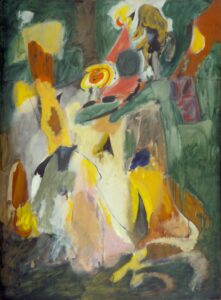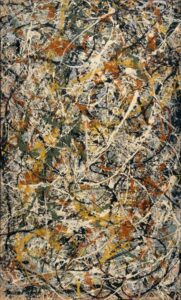
Matisse: Harmony in Red (1908)
SUMMARY: The quintessential art critic of the 1940s was Clement Greenberg, but In later years his dogmatism came under fire. Two volumes of his finest essays, “Perceptions and Judgments, 1939-1944” and ‘Arrogant Purpose, 1945-1949,” edited by John O’Brian (University of Chicago Press, $27.50 each), should help to restore his reputation.

Invigorating is the best way to describe the early writings of the immensely powerful New York intellectual and art critic Clement Greenberg. An early champion of the abstract expressionists (in 1947 he was ridiculed by Time magazine for calling Jackson Pollock “the most powerful painter in America”), Greenberg was uncannily prescient in his judgments.
Moreover, he brought to American art criticism a seriousness and depth of analysis that had been notably lacking. As art critic for The Nation from 1942 to 1947 and as contributing editor to Partisan Review during the ‘40s, he wrote some of the most cogent and influential essays on art ever written in the United Slates.
Since 1970, however, Greenberg has been under attack by artists and critics who found his later prescriptions for American modernism too narrow and constrictive.
John O’Brian’s twin volumes — “Perceptions and Judgments, 1939-1944” and “Arrogant Purpose, 1945-1949” — should do much to restore the critic’s reputation. The muscularity of his prose, the headlong acceleration of his thought, the acuteness of his perceptions are exhilarating indeed.
In part, Greenberg’s criticism is so good because he conceived of the critic’s role in its largest sense. At one point he quotes Matthew Arnold: ‘To ascertain the master current in the literature of the epoch and to distinguish this from all minor currents, is one of the critic’s highest functions.”
Greenberg went further. A Trotskyite Marxist in the 1930s, he maintained a Marxist view of history as an unfolding dialectic, even after he was thoroughly disillusioned with Soviet communism. He constantly tested the art he saw against the full sweep of history and chastised it if, in his view, it was unworthy of that challenge.
For him art values were not innate. He did not believe in the existence of a universally recognizable “significant form” suggested by the English critic Roger Fry. Rather, he felt that each epoch had to develop its own appropriate forms.
However, Greenberg saw 20th century Western art as being afflicted by its socioeconomic environment — interpreted by the critic as the agonizing last throes of capitalism. He outlined this theory in his first long critical essay, “Avant-Garde and Kitsch” Written for Partisan Review in 1939, when he was 30, this is the critic’s key work — a brilliant and astonishingly mature manifesto that provided a sturdy theoretical framework for his writings over the next decade.
The avant-garde, he explains, exists to keep “culture moving in the midst of ideological confusion and violence.” The reason why the avant-garde turned to the abstract in the early 20th century was to find a fixed point of reference, an “absolute” that could stand up against the political, social and economic storms afflicting West European society.
This “absolute” Greenberg found in the artists’ study of their own media. “Picasso, Braque, Mondrian, Miro, Kandinsky, Brancusi, even Klee, Matisse and Cezanne derive their chief inspiration from the medium they work in,” he wrote. “The excitement of their art seems to lie most of all in its pure preoccupation with the invention and arrangement of spaces, surfaces, shapes, color, etc., to the exclusion of whatever is not necessarily implicated in these factors.”
While the idea that artists had to withdraw from 19th century bourgeois society in order to preserve their creativity had been stated before, Greenberg brought to the equation two new ideas — first, that culture has its own momentum, dialectically unfolding in a separate if parallel motion to that of society; second, that art’s exploration of its own means exerts a kind of ethical-aesthetic check on art’s natural tendency to become impure.

This picture of an alienated and mobile but strongly cohesive and regulated culture was reinforced by Greenberg’s own background, His parents came from the Lithuanian Jewish cultural enclave in northeastern Poland, and he spoke Yiddish as soon as he did English. In more than a few of these essays, he speaks directly about the Jewish experience.
One of the most revealing is an outraged review of Peggy Guggenheim’s 1946 art world memoir, “Out of This Century.” Writing for Commentary under the pseudonym “Hardesh” (Yiddish for Greenberg), he asks: “Is this how naked and helpless we Jews become once we abandon our ‘system’ completely and surrender ourselves to a world so utterly Gentile in its lack of prescriptions and prohibitions as Bohemia really is?”
At the same time he was immensely proud of his heritage. In an attack on Arthur Koestler he writes, “It is possible that by ‘world-historical’ standards the European Jew represents a higher type of human being than any yet achieved in history. I do not say that it is so, but I say it is possible, that there is much to argue for its possibility.”
To a large extent Greenberg projected his powerful feelings about Jewish alienation and culture onto the culture of the avant-garde he found in New York.
However, as a dialectical materialist he was also careful always to test feeling and theory against facts. More than once in these essays, he insists that the high quality of the abstract paintings and sculpture he saw around him persuaded him of the justness of his theory, not the other way around.
“Art, which succeeds in being good only when it incorporates the truth about feeling, can now tell the truth about feeling only by turning to the abstract,” he wrote. “1 do not say this out of dogmatism — art cannot be prescribed to — but only because the incidence of good art has become so much greater in the area of the abstract than elsewhere.”
Indeed, in these early essays there is little of the dogmatism that marred Greenberg’s later writing. Rather, the reader is infected with his sense of a great adventure.
Before his very eyes, American artists were seizing the leadership of the avant- garde from Paris, were producing better and more challenging art in spite of dire poverty and neglect. In review after review, he exults (always judiciously) in the growing powers of Pollock, painter Arshile Gorky and sculptor David Smith, sometimes chiding them but always cheering them on like a fond but strict parent.
While the drama of Greenberg’s criticism lies in its unstoppable momentum, he also is extremely acute in his description of what goes on between the work of art and the artist and between the work of art and the spectator.
Particularly felicitous, for example, is his discussion of the shortcomings of the paintings of Georges Rouault. His “histrionic impatience, the anxiety to express, makes him try to rape the medium and anticipate the spectator’s emotions by presenting a fait accompli before the fact — there the spectator’s emotion is in the picture before he has had time to feel it. He gets a portrait of the way he ought to feel. And so many of us feel guilty about emotional impotence that we hurry to assent.”
Unhappily, Greenberg must bear a large share of the blame for his own eclipse. As he became more powerful, he rejected this kind of sensitive analysis in favor of simple assertions. In fact, during the 1950s and ’60s, he was moved by his own rhetoric past the point of dogmatism to self-indulgence.
Many of the essays (including the one on Rouault) were heavily rewritten for his well-known 1961 book, “Art and Culture: Critical Essays” — and not for the better. In the later version, the passage quoted on Rouault reads: “1 myself must confess a real distaste for the artistic personality I discern in his pictures and I must also confess that I tend to suspect the unconscious motives of those who praise him.”

The value of criticism rests as much in the critic’s process of thought as in his final judgments. The rewritten essays are pompous because the reader is denied the benefit of the conscientious self-questioning that was so intrinsic a part of Greenberg’s original critical method.
There is another, deeper reason for the decline of Greenberg as an effective critic. He became so caught up with his own theories that he overstepped the limits of the critic and tried to prescribe to art. One sees him veering down this dangerous road in the final essay of this collection, “Our Period Style” (1949). After an attempt to define the “period style” of his contemporaries, he suggests that “rationalization” is the appropriate style for an industrial culture — “a vision of that complete and positive rationality which seems to me the only remedy for our present confusions.” In these words are the seeds of “minimalism,” that monkish aesthetic so decisively overthrown by the present generation.
Greenberg got caught in a political trap of his own making. He tried to dream up a working-class art that conformed to his ideals: rational, efficient, with an almost transcendent work ethic. Pop Art, which was truly working-class in its origins, caught him completely off base. Of course, he hated it, but that story lies outside this review.
There is much more of value in these essays than appears above. No critic today enjoys even half the respect and influence that Greenberg had in his prime. This is not because there is now too much art or even because there is too much bad art, but because no writer today has half Greenberg’s ability to make great contemporary art seem so urgently necessary to contemporary life.
Jane Addams Allen
By kind permission of the Washington Times
Volume 33.no.1 September / October 2018 pp 20-22


Also to be considered is the role of the CIA in promoting Abstract Expressionism. “How New York Stole the Idea of Modern Art” by Serge Guilbaut. Strange bedfellows, the CIA and Greenberg. Likely he didn’t know… For a while now I’ve been disturbed by the thought that the Avant Garde consist of a group following a common ideology. It suggests history is made by bullies.
Hi Miklos,
How true, “It suggests history is made by bullies”, considering the bullies of today who operate only for their economic interest, often with terrifying consequences and total disregard of human rights. They do, indeed, make history; however, we need to defend our freedom of the press. Silence is deadly, while defending freedom of the press can be deadly in the real sense.
<3
Prior to our time, art history has been made by superior art, most of which can be construed as belonging to this or that specific group with both shared and not so shared viewpoints. Whether this continues in the future seems unlikely. Pluralism has spawned a large number of groups with shared viewpoints, but has also led to deprecating thoughts like “superior art”, substituting “relevant”, “new”, “revolutionary”, “provocative”, and others, each the more the better, as the preferred modes for paying attention to art. I really don’t know where this will wind up or how long it will last.